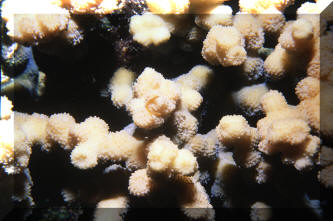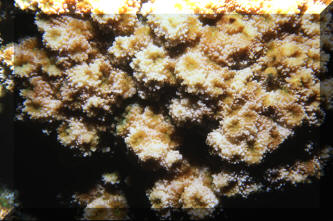 |
|
| Home | Marine Aquariums |
Freshwater Aquariums |
Planted Aquariums |
Brackish Systems |
Ponds,
lakes & fountains |
Turtles & Amphibians |
Aquatic Business |
Aquatic Science |
Ask the WWM Crew a Question |
| Please visit our Sponsors | ||||
Family Merulinidae Verrill 1866. Five extant genera, all Pacific. All hermatypic. Readily identified by the families characteristic fused corallite wall/mounds called hydnophores. Strong septa are apparent even in open colonies.
From Wikipedia:
|
||||||||||||||||||||||||||||||
| Caulastrea cf curvata (Milne Edwards and Haime 1849).
?COTW: Characters: Colonies are usually small. Corallites are sometimes compact, but usually sprawl irregularly. They are characteristically curved at the colony periphery and average 8 millimetres diameter. Colour: Pale brown. Similar Species: Caulastrea furcata, which can be distinguished underwater by its colour; corallites are also more regular, larger, have more numerous septa and better developed costae. Habitat: Flat substrates, often found with C. furcata. Abundance: Uncommon. Fiji pic. |
| Caulastrea echinulata Wijsman-Best 1972. Though septa are exsert, they're all about the same size. Small polyps, fleshy. Aquarium photo. |
|
| Caulastrea furcata Dana 1846. Small corallites (under 10 mm. in diameter). Septa are irregular, some much larger (tooth-like) than others, sticking out. Have distinctive "candy cane" appearance. Common in the wild and captivity. Easily kept, cultured, reproduced by fragmentation. Aquarium pix. |
|
| Bigger PIX: The images in this table are linked to large (desktop size) copies. Click on "framed" images to go to the larger size. |
|
|
Genus Cyphastrea
| Bigger PIX: The images in this table are linked to large (desktop size) copies. Click on "framed" images to go to the larger size. |
Genus Echinopora (placed in the family
Faviidae in the recent past.... see there as
well)
Genus Echinopora Lamarck 1816. As per the name, prickly in
appearance (raised corallites, spiny septa). Mostly wavy laminar sheets
that appear wavy on their ends.
| Echinopora forskaliana (Milne Edwards & Haime, 1849).
/COTW: Characters: Colonies are massive, with little tendency to form plates. Corallites are tall and conical, up to 10 millimetres diameter. Long and short septo-costae slightly alternate and are neatly and uniformly beaded. Paliform lobes form a neat crown. The columella has spines twisted into a spiral. Colour: Pink, sometimes brown. Similar Species: Echinopora robusta. See also E. gemmacea which has less exsert corallites and tends to form plates rather than massive colonies. Habitat: Shallow reef environments.
Abundance: Common. |
| Echinopora fructiculosa (Ehrenberg 1834). Dome shaped
colonies of interlocking branches. Branches are single tubular corallites
with lateral budding. Corallites 5-8 mm. Color pinkish brown w/ light
colored ends. Red Sea 2019. http://www.coralsoftheworld.org/species_factsheets/species factsheetsummary/echinopora-fruticulosa/ |
| Echinopora fructiculosa, Red Sea, Sinai pix |

 |
| Echinopora lamellosa (Esper 1791). /COTW: Characters: Colonies are thin laminae arranged in whorls or tiers or, rarely, forming tubes. Stands over 5 metres across are not unusual. Corallites are relatively thin walled and small (2.5-4 mm diameter). Columellae are small and compact, and paliform lobes are well developed. Colour: Amber, pale to dark brown or greenish, often with darker brown or green calices. Similar Species: Echinopora ashmorensis, E. pacificus and E. gemmacea. Habitat: May be a dominant species in shallow water habitats with flat substrates.
Abundance: Common. |
|
| Echinopora lamellosa. E costata has larger corallites, horizontal plates, and the radiating ridges go right through corallites near the edge of the plate, rather unbelievable. I found it in Indonesia, not sure anybody else has seen it yet. The only pictures Veron has on www.coralsoftheworld.org are the ones I took. Only saw it at one dive spot, got sample, got the species named. Never seen it again but I haven't been back to Indonesia. Indonesia is a a bigger place than most people realize, because those stupid flat maps everyone likes to use (Mercator projection) hugely distort the world, making Greenland look hugeer than it is and Indonesia small. Indonesia is longest east-west,and north-south at one point it is as far as London to St. Petersburg, Russia. /Douglas Fenner via FB | |
| Bigger PIX: The images in this table are linked to large (desktop size) copies. Click on "framed" images to go to the larger size. |

|
Features: |
|
| Featured Sponsors: |